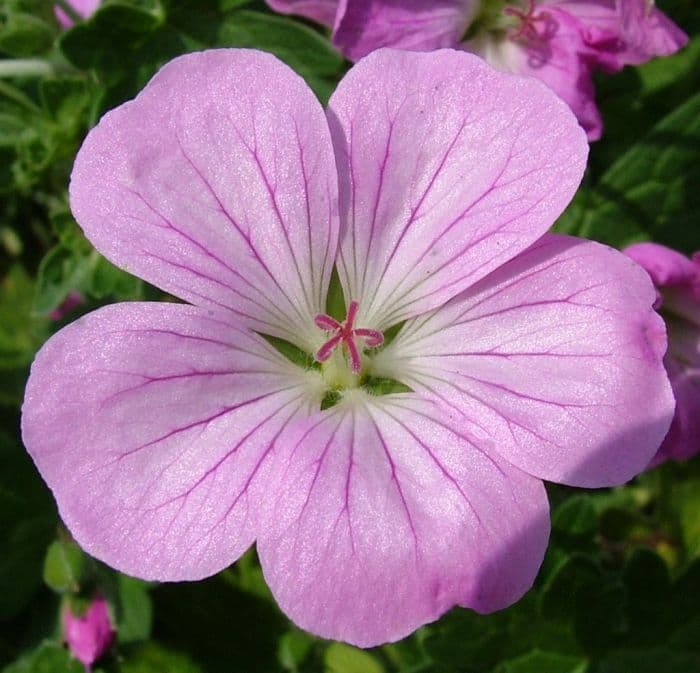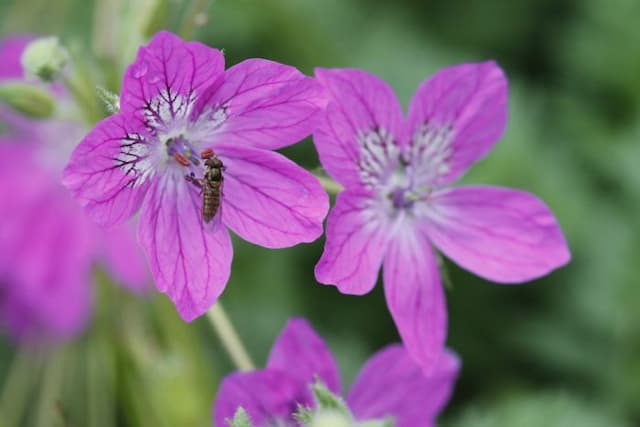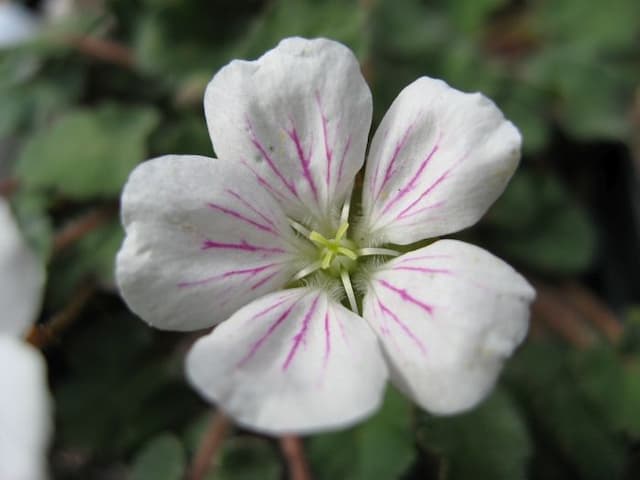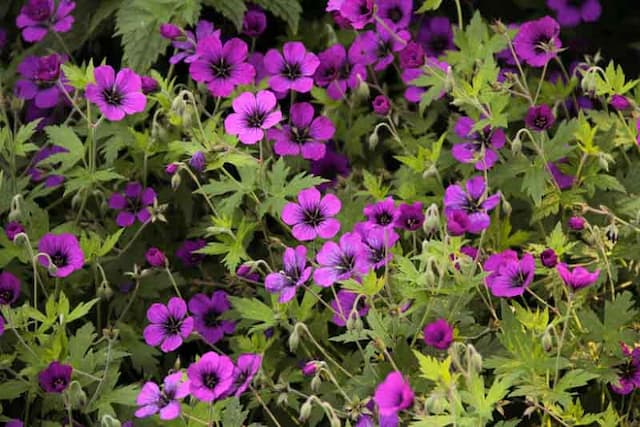Geranium Geranium 'Mavis Simpson'

ABOUT
Geranium 'Mavis Simpson' is a charming perennial known for its long-lasting, soft pink flowers. The plant bears rounded leaves that are softly lobed and have a plush, velvety texture. The foliage often displays a greyish-green hue, contributing to the plant's muted and subtle backdrop. From late spring to early autumn, it produces an abundance of flowers. Each flower is characterized by its rounded, open form with five petals, and the blossom's heart usually has darker pink veining that adds depth and interest to the overall soft pink coloration. While it is a clumping plant, its flowers are carried on slender, trailing stems, which creates an airy and relaxed appearance. With its gently spreading habit, 'Mavis Simpson' brings a casual elegance to any garden space, beautifully complementing other plantings with its understated blooms and attractive foliage.
About this plant
 Names
NamesFamily
Geraniaceae.
Synonyms
Mavis Simpson Geranium, Hardy Geranium, Cranesbill.
Common names
Geranium 'Mavis Simpson'.
 Toxicity
ToxicityTo humans
Geranium 'Mavis Simpson' is generally considered non-toxic to humans. If ingested, it is unlikely to cause any serious symptoms of poisoning.
To pets
Geranium 'Mavis Simpson', also known simply as geranium, is also generally non-toxic to pets. Ingestion of this plant should not cause significant symptoms of poisoning in animals. However, individual animals may have different sensitivities, and it's always best to prevent pets from eating plants as a precautionary measure.
 Characteristics
CharacteristicsLife cycle
Perennials
Foliage type
Deciduous
Color of leaves
Green
Flower color
Pink
Height
1-2 feet (30-60 cm)
Spread
1-2 feet (30-60 cm)
Plant type
Herb
Hardiness zones
5
Native area
Middle East
Benefits
 General Benefits
General Benefits- Attracts pollinators: Geranium 'Mavis Simpson' is known to attract bees and butterflies, which help pollinate other plants in the garden.
- Drought-tolerant: Once established, it is quite tolerant to drought, making it suitable for xeriscaping or low-water gardens.
- Ground cover: Due to its spreading habit, it can cover ground effectively, suppressing weeds and reducing maintenance.
- Long flowering period: It blooms over a long period from late spring to fall, providing extended color in the garden.
- Easy to care for: This geranium is low maintenance, requiring minimal care once established.
- Deer and rabbit resistant: It is generally resistant to browsing by deer and rabbits, protecting it from wildlife damage.
- Provides erosion control: The plant's dense growth can help stabilize soil and prevent erosion.
- Aesthetic appeal: With its soft pink flowers and silvery-green foliage, Geranium 'Mavis Simpson' adds a splash of color and texture to any garden space.
- Non-invasive: Unlike some geranium species, 'Mavis Simpson' is not invasive and stays within its allotted space.
- Versatile planting: Suitable for borders, rock gardens, and containers, offering versatility in garden design.
 Medical Properties
Medical PropertiesThis plant is not used for medical purposes.
 Air-purifying Qualities
Air-purifying QualitiesThis plant is not specifically known for air purifying qualities.
 Other Uses
Other Uses- Herb sachets: Leaves of the Geranium can be dried and used in sachets to impart their scent in drawers and closets.
- Plant dye: The flowers and leaves, when boiled, can produce a natural dye for fabrics or crafting projects.
- Culinary garnish: Edible flowers of the Geranium can be used to decorate cakes and pastries.
- Floral crafts: Fresh or dried Geranium flowers can be used in wreaths, arrangements, or potpourri for their color and fragrance.
- Natural insect repellent: The Geranium plant can be strategically positioned in gardens or on patios to deter certain insects with its scent.
- Companion planting: Geranium can be planted alongside vegetables like tomatoes to help repel pests.
- Educational tool: Geraniums can be used to teach botany and horticulture due to their easy-to-observe growth and reproductive cycles.
- Scented stationery: Rubbing Geranium leaves on paper can infuse the paper with a subtle fragrance for a unique touch to handwritten letters.
- Photography subjects: Geraniums, with their vivid colors and textures, make excellent subjects for botanical photography.
- Creative arts: Pressed Geranium flowers can be used in creating botanical prints or incorporated into mixed-media art projects.
Interesting Facts
 Feng Shui
Feng ShuiThe plant Geranium is not used in Feng Shui practice.
 Zodiac Sign Compitability
Zodiac Sign CompitabilityThe plant Geranium is not used in astrology practice.
 Plant Symbolism
Plant Symbolism- Unexpected Encounter: The Geranium 'Mavis Simpson', with its distinct appearance, symbolizes chance meetings and surprises, perhaps pointing to the unexpected ways in which joy can enter one's life.
- True Friendship: This plant is often associated with the bond of true friendship, representing the deep connection and understanding between close friends.
- Tranquility: The soft pink hues and gentle demeanor of the Mavis Simpson convey a sense of calm and peace, making it a symbol for tranquility.
- Good Health: Historically, geraniums have been used for their medicinal properties, and so this plant can signify wishes for good health and well-being.
 Water
WaterHardy geraniums, like the 'Mavis Simpson', should be watered deeply but infrequently to encourage a strong root system. Typically, watering once a week with approximately 1 inch of water should suffice if there has been no significant rainfall. During the hotter and drier summer months, you may need to increase watering to twice a week. Always allow the soil to dry out slightly between waterings to prevent overwatering and root rot. It's best to water early in the morning or in the evening to reduce evaporation.
 Light
LightGeranium 'Mavis Simpson' prefers to grow in full sun to partial shade. It thrives best when it receives at least 6 hours of direct sunlight per day, so placing it in an area that's exposed to the morning sun with some afternoon shade would be ideal. However, it can still perform well with a little more shade, particularly in hotter climates where some protection from the intense afternoon sun can be beneficial.
 Temperature
TemperatureHardy geraniums like 'Mavis Simpson' can tolerate a range of temperatures but grow ideally in zones that experience temperatures between 60 to 75 degrees Fahrenheit. While they can survive temperatures as low as 20 degrees Fahrenheit, it is best to provide some protection or mulching in the winter in colder zones. During extreme summer temperatures over 85 degrees, some afternoon shade may help protect the plant.
 Pruning
PruningPruning 'Mavis Simpson' geranium should be done to remove spent flower stems and encourage bushier growth and more blooms. It is best to prune right after the first flowering in late spring or early summer. Periodic deadheading of the faded flowers can continue throughout the summer months to keep the plant looking tidy and to promote continuous blooming.
 Cleaning
CleaningAs needed
 Soil
SoilThe best soil mix for Geranium 'Mavis Simpson', commonly known as cranesbill, is well-draining soil that is rich in organic matter, with a mix of two parts peat or compost, one part garden soil, and one part coarse sand or perlite. The ideal soil pH should be slightly acidic to neutral, around 5.8 to 7.2 for optimal growth.
 Repotting
RepottingCranesbills like Geranium 'Mavis Simpson' should be repotted every 1 to 2 years to refresh the soil and allow for continued growth. Repot in spring or early summer before they begin their active growing season.
 Humidity & Misting
Humidity & MistingCranesbill, or Geranium 'Mavis Simpson', performs well in average room humidity. There is no need for high humidity levels; regular ambient humidity found in most homes is sufficient for this plant.
 Suitable locations
Suitable locationsIndoor
Place in bright, indirect light with well-draining soil.
Outdoor
Needs full sun to part shade in well-draining soil.
Hardiness zone
5-9 USDA
 Life cycle
Life cycleGeranium 'Mavis Simpson' begins its life cycle as a seed, which germinates in spring when soil temperatures warm up. The seedling emerges and grows into a young plant with a rosette of leaves at ground level. Over the following weeks, the plant develops a strong root system and foliage. During late spring to summer, it enters the flowering stage, producing pink flowers that attract pollinators and lead to seed formation. Once flowering is complete, seeds are dispersed, and the plant may undergo a period of dormancy, especially in colder climates, where the above-ground parts die back in winter. In spring, the cycle resumes as the plant regrows from its rootstock or from newly germinated seeds.
 Propogation
PropogationPropogation time
Spring-Early Summer
Geranium 'Mavis Simpson', a popular perennial, is commonly propagated through stem cuttings. This method can be undertaken during late spring or early summer to capture the plant's vigorous growth for successful rooting. A healthy non-flowering stem around 4-6 inches (10-15 cm) long is selected and cut just below a leaf node. Leaves on the lower half of the cutting are removed to prevent excess moisture loss and potential rot. The cutting is then dipped in rooting hormone to encourage root development and planted in a mix of potting soil and perlite or sand to ensure good drainage. The cutting should be kept in a warm, bright area but out of direct sunlight and maintained with consistent moisture until the roots establish, usually within a few weeks, at which point it can be transplanted.









![Cranesbill [Rothbury Gem]](/_next/image?url=https%3A%2F%2Fplants-admin.emdemapps.com%2Fimages%2Fplants%2F%2Fimages%2F604b6243984c2.png&w=640&q=75)